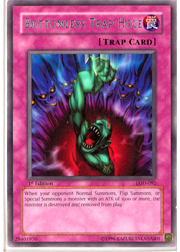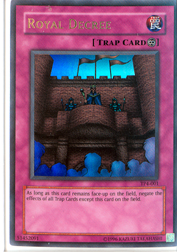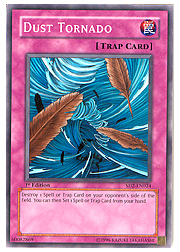One of my biggest personal triumphs as a duelist was in Charlotte, North Carolina, which was the site of a massive Shonen Jump Championship that drew hundreds of duelists. At that event, the true power of a pure Zombie build was unleashed, providing hope for many duelists that decks could overcome the lack of Black Luster Soldier – Envoy of the Beginning being mindlessly splashed in many decks. It’s a rare opportunity when a writer can provide insight for the metagame by looking at his or her own deck, but I’ll take this chance to write about my own experiences.
 You see, the trap lineup hasn’t changed much with the new Forbidden list. The only cards that have gone missing are Mirror Force and Ring of Destruction, which can easily be replaced by one-for-one traps such as Bottomless Trap Hole or Sakuretsu Armor without a loss of utility. Compare that to the standard spell lineup, which has lost over half of its arsenal!
You see, the trap lineup hasn’t changed much with the new Forbidden list. The only cards that have gone missing are Mirror Force and Ring of Destruction, which can easily be replaced by one-for-one traps such as Bottomless Trap Hole or Sakuretsu Armor without a loss of utility. Compare that to the standard spell lineup, which has lost over half of its arsenal!
Your trap selection has many subtle and far-reaching effects that aren’t immediately apparent. My build theme, Zombies, was generated after first selecting my trap theme. That theme featured three copies of Dust Tornado, a combination that had never seen success in a top-level tournament. I’ll now argue that in this new metagame, your trap lineup will determine the rest of your deck. Currently, there are three methods of trap selection in the environment, which is a trend that’s expected to continue in the new metagame. Let’s analyze these three methods.
The Standard Trap Lineup
This is the lineup that will appear in most cookie-cutter decks. The standard part of this description refers to the fact that the lineup features no pieces of “tech,” or cards designed to combat the metagame. Instead, it simply features the remaining two trap staples (Call of the Haunted and Torrential Tribute), and a few more copies of generic defensive traps, such as Sakuretsu Armor and Bottomless Trap Hole.
This method is popular for a reason—it’s sturdy and consistent. Traps, unlike their quick-play spell brethren, usually pay for themselves. What that means is that Sakuretsu Armor takes the monster down with it, whereas with a spell like Book of Moon, you’d need to follow up with an attack to pay for its cost. Therefore, this type of lineup that features one-for-one trades is highly stable as well as thematically consistent with almost any deck.
The Royal Decree Trap Lineup
 The next two trap lineups listed evolved out of a need to combat the standard trap lineup. This build focuses on outright trap negation through multiple copies of Royal Decree. This option doesn’t use the common staple traps, instead choosing to run a few essentials. The trap count for this deck is always five or less.
The next two trap lineups listed evolved out of a need to combat the standard trap lineup. This build focuses on outright trap negation through multiple copies of Royal Decree. This option doesn’t use the common staple traps, instead choosing to run a few essentials. The trap count for this deck is always five or less.
Defenses were once bolstered by multiple copies of quick-play spells like Scapegoat, Book of Moon, and Enemy Controller, but this strategy has taken a huge hit with the limiting of both Scapegoat and Book of Moon. One can almost argue that the Royal Decree build has been left completely unviable, but creative duelists will look to unlock these advantages.
As I mentioned in my article on prevention versus negation, Royal Decree generates tremendous advantage with very little downside. Imagine if you declare an attack into a face-down monster with your Blade Knight. Your opponent, eager to preserve his Magician of Faith, activates Sakuretsu Armor. Your chained Royal Decree now negates his trap, providing a one-for-zero advantage, and his Magician of Faith that would have been protected is now destroyed. These types of advantage swings are then amplified by running a monster lineup that possesses great synergy with trap negation. More specifically, the Royal Decree decks include monsters that generate effects upon doing battle damage.
Imagine, if you will, a Spirit Reaper that’s attempting to steal part of your opponent’s spirit, or perhaps an Airknight Parshath trying to draw a card. If you have Royal Decree active, over one-half of your opponent’s defensive options are gone. Sure, he or she might have a single copy of a quick-play spell to stop you, but not many will be played in this new format!
This type of build, while weakened by a few key losses, remains very strong in all its aspects. Team Savage tested it numerous times with David Simon and Tony Lee, falling just short of a Top 8 at Shonen Jump Indy. However, it tends to unravel quickly against a monster that dominates the board with the highest ATK value. Royal Decree’s single weakness is that it can’t simply be “turned off,” because it’s a continuous trap. A summoned Cyber Dragon or other beefy monster can quickly turn the tide as your own Decree prevents a steady defense.
The Bes . . . I Mean, the Dust Tornado Trap Lineup
Sorry, I got a little carried away there in my description.
This build was brought to the forefront by Team Savage—namely, Evan Vargas at Gen Con Indy (before we were teammates), and then my Zombie build at the Charlotte Shonen Jump Championship. It focuses on the “big four” group of traps, then adds three copies of Dust Tornado, usually with a copy of My Body as a Shield waiting in the wings. Why exactly did this build succeed? Let me count the ways.
1. In a static metagame with very few massive resource swings, the best way to get an advantage is through battle.
 I realized while testing that clearing out traps and other threats, then bringing out a stronger monster in battle, was a good tactic indeed. The Zombie deck capitalized on this synergy, as Dust Tornado would clear out the backfield while Pyramid Turtle went to work. It hearkens back to the days of Beatdown decks, when the strongest monsters constantly dominated the field.
I realized while testing that clearing out traps and other threats, then bringing out a stronger monster in battle, was a good tactic indeed. The Zombie deck capitalized on this synergy, as Dust Tornado would clear out the backfield while Pyramid Turtle went to work. It hearkens back to the days of Beatdown decks, when the strongest monsters constantly dominated the field.
Of course, after the release of Invasion of Chaos, Beatdown began to see less play and the metagame swung back in favor of Control archetypes. The sheer logic of “without spell or trap protection, my stronger monster will beat yours,” was forgotten. It took a rogue deck to bring this concept back in vogue.
2. There are very few counters to continuous spell or trap pieces of tech.
Current pieces of tech have provided many players with advantages in the metagame. I’m talking about cards like Wave Motion Cannon and Messenger of Peace, which are two cards that can completely wreck your board strategy. Both of these cards cannot be reliably countered by the three pieces of removal that most decks pack.
With the new format, you can expect even more of these deadly original cards, whether it’s in a Gravekeeper deck centering around Necrovalley or a new-school Water deck featuring A Legendary Ocean.
3. Combinations are deadly.
The final key to Dust Tornado is the rich array of tactical combinations that it can create. Here are a few examples.
—I can use Dust Tornado at the end phase, hitting my opponent’s trap, then set Call of the Haunted from hand to play. Setting both would be too risky, but Dust Tornado provides a nice opportunity with minimal risk.
—In a game from the now-legendary Team Savage versus Team Odyssey battle, Wilson Luc chained Dust Tornado to a flipped Morphing Jar, setting Pot of Greed from his hand.
—At Shonen Jump Seattle, one of my main combos was a Dust Tornado in the end phase that turned into Robbin’ Goblin, which could then immediately be activated.
Throw in the fact that it’s also one of the best counters to the two biggest game-breaking spells, Snatch Steal and Premature Burial, and it’s not hard to see why the Dust Tornado build is so popular and deadly.
Final Assessment
The upcoming Forbidden list in October should turn the metagame on its head one more time. When constructing a new deck, try to keep in mind the complex ways in which your monsters, spells, and traps interact. Usually, building the deck from the ground up and making sure that everything works synergistically is the key to success. Chances are good that you won’t beat a great player at his or her own game by just copying a deck from the Internet, so you’ll need to adapt and create your own unique strategies to get an edge.